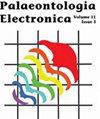鸟臀目恐龙Styracosaurus和Thescelosaurus的前肢运动和方向及其对运动和其他行为的启示
IF 1.5
4区 地球科学
Q2 PALEONTOLOGY
引用次数: 0
摘要
本文章由计算机程序翻译,如有差异,请以英文原文为准。
Forelimb motion and orientation in the ornithischian dinosaurs Styracosaurus and Thescelosaurus, and its implications for locomotion and other behavior
The range of motion (ROM) in the forelimb has previously been studied in many saurischian dinosaur species but only a few ornithischian dinosaur species. Here, we fill in some of the blanks in current knowledge of ornithischian forelimb function by investigating the range of shoulder motion and the orientation of the humerus, radius, and ulna in the centrosaurine ceratopsid Styracosaurus albertensis and the basal orni-thopod Thescelosaurus sp. Manual manipulation of forelimb bones, using the margins of bony articular surfaces to delimit the range of motion, shows that humeral ROM and forearm orientation in S. albertensis resemble those previously found in chasmosau-rine ceratopsians. Locomotion occurred with the elbows tucked in at the sides and with the radius anterior to the ulna, without pronation. The animal was also capable of splaying its forelimbs with the elbows strongly everted, so that elbow flexion and extension produced side-to-side or up-and-down movements of the torso and head. Thesce-losaurus sp. had limited humeral ROM and could not swing its humerus forward through the parasagittal plane as far as a vertical orientation. While being swung upward through the transverse plane, the humerus could not move as high as a horizontal position. Skeletal proportions and spinal curvature indicate that the forelimbs of Thescelosaurus could contact the ground while the animal stood. However, the animal is unlikely to have used quadrupedal locomotion, because its palms faced medially, and its fingers would have flexed through the transverse plane and therefore would not have provided forward propulsion
求助全文
通过发布文献求助,成功后即可免费获取论文全文。
去求助
来源期刊

Palaeontologia Electronica
PALEONTOLOGY-
CiteScore
3.30
自引率
0.00%
发文量
20
审稿时长
>12 weeks
期刊介绍:
Founded in 1997, Palaeontologia Electronica (PE) is the longest running open-access, peer-reviewed electronic journal and covers all aspects of palaeontology. PE uses an external double-blind peer review system for all manuscripts. Copyright of scientific papers is held by one of the three sponsoring professional societies at the author''s choice. Reviews, commentaries, and other material is placed in the public domain. PE papers comply with regulations for taxonomic nomenclature established in the International Code of Zoological Nomenclature and the International Code of Nomenclature for Algae, Fungi, and Plants.
 求助内容:
求助内容: 应助结果提醒方式:
应助结果提醒方式:


